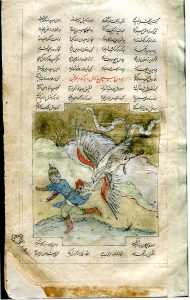An Illustrated Leaf from the Shahnameh with a Russian Watermark
August 4, 2021 in Manuscript Studies
An Illustrated Persian Leaf on Paper
from the Shahnameh
(Humai & Darab)
with a Russian Watermark
[Posted on 5 August 2021]
Continuing our examination of Watermarks and the History of Paper, we display an illustrated paper leaf from an illustrated manuscript which has come to our notice. Its owner identified the text, but wondered about the watermark. Responding to our blog, he offered its images for examination.

Private Collection, Leaf from a Persian Shanameh. Simurgh and Zal.
Now in a private collection, the detached leaf formerly belonged to an illustrated manuscript in Persian of the Shahnameh or ŠĀH-NĀMA / Šāhnāme (شاهنامه or “Book of Kings”), the renowned epic poem by the Persian poet Abul-Qâsem Ferdowsi Tusi or Ferdowsi (circa 329 – 411 AH / 940 – 1010 CE). This poem, which the poet began to compose circa 977 CE and completed on 8 March 1010 CE, extends for more than 50,000 couplets. Its text recounts the history of the kings and heroes of Persia from mythical times to the overthrow of the Sassanids by the Arabs in the middle of the 7th century.
The importance and popularity of the text ensured that it has circulated in very many copies produced at various times and in various places, manuscripts included. Not all of them survive, and some survive only in pieces.
An earlier post in our blog (see its Contents List) considered a detached leaf from another portion of the epic, from another illustrated manuscript, and in another private collection.
Simurgh and Zal from a Persian Shahnameh.
That leaf illustrates an episode from the fabulous story of the winged creature Simurgh and her adopted human warrior son Zāl. Within a stepped frame set within the page of text, its illustration depicts the large creature as she swoops down to grasp or grab him by the waistband as he flees.
The ‘new’ leaf belongs to a different episode, a different manuscript, and a different style of illustration, in the long and richly varied tradition of illustrations for the Shahnameh or Šāh-nāma in books and other visual arts, and in Persian and other spheres.
Humai and Darab
Among the Episodes of the Shahnameh, the sections devoted to a legendary queen of Iran, Humai or Humay Chehrzad (sections 609–614 in one form of reckoning), recount events of her reign within the legendary Kayanian dynasty. They relate the birth of her son Kai Darab, her abandonment of him as an infant, her recognition of him as an adult as her son, after he had helped to defeat the attacking Romans at the edge of the Iranian Empire. These sections end with her retirement from the throne in favor of him as the next king, Dara I.
The text on the leaf belongs to the episode that recounts how, after “Darab fights against the Host of Rum” (612), “Humai recognises her Son Darab” (613).
